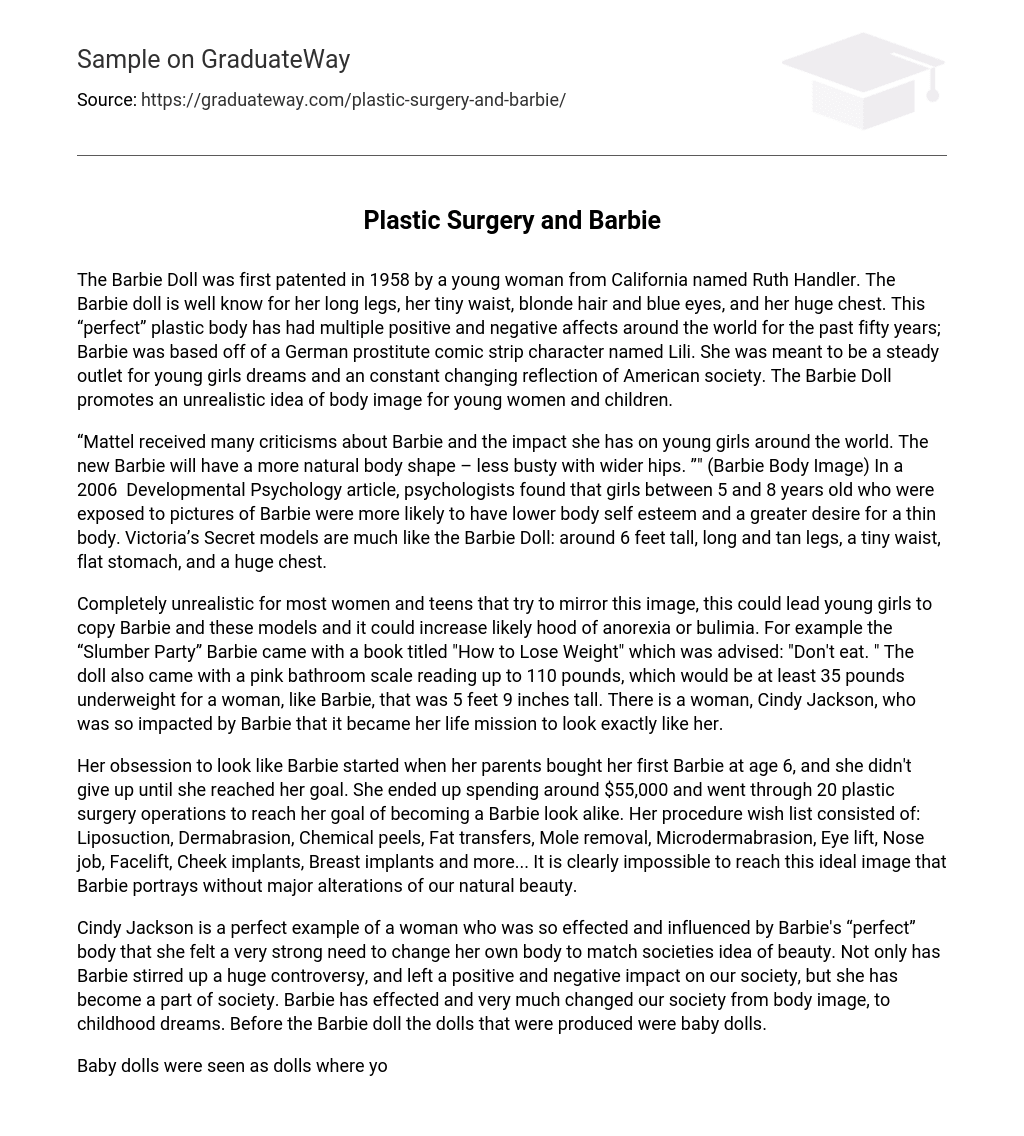The Barbie Doll, first patented in 1958 by Ruth Handler, a young woman from California, is famous for its long legs, tiny waist, blonde hair, blue eyes, and large chest. This idealized plastic body has had both positive and negative impacts globally over the past five decades. Barbie was inspired by Lili, a character from a German prostitute comic strip, and was intended to serve as an ever-evolving representation of American society and a means for young girls to express their dreams. However, the Barbie Doll also promotes an unrealistic body image for young women and children.
Mattel received criticism for the impact of Barbie on young girls worldwide. As a response, they introduced a new Barbie with a more natural body shape – less focus on a busty figure and instead featuring wider hips (Barbie Body Image). According to psychologists mentioned in a 2006 Developmental Psychology article, girls aged 5 to 8 who saw Barbie images had higher chances of having lower body self-esteem and an increased desire for a thin body. Similarly, Victoria’s Secret models typically have similar physical attributes as Barbie dolls: tall height (around 6 feet), long and tan legs, small waist, flat stomach, and large chest.
Barbie and fashion models present an unrealistic image that can harm women and teens, potentially leading to eating disorders like anorexia or bulimia. The “Slumber Party” Barbie exemplifies this issue, as it included a book titled “How to Lose Weight” that encouraged young girls to avoid eating. Furthermore, the doll came with a pink bathroom scale capable of measuring up to 110 pounds, which is at least 35 pounds underweight for someone of Barbie’s height (5 feet 9 inches). A woman named Cindy Jackson was so influenced by Barbie that she dedicated her life to achieving her appearance.
At the age of 6, her parents purchased her first Barbie doll, igniting her fixation with emulating the renowned toy. She was resolute in achieving this objective and ultimately spent around $55,000 on 20 cosmetic surgeries to resemble Barbie. Her desired procedures encompassed liposuction, dermabrasion, chemical peels, fat transfers, mole removal, microdermabrasion, eye lift, rhinoplasty, facelift, cheek implants, breast implants, and more. It is clear that conforming to the idealized image projected by Barbie mandates substantial modifications to our innate beauty.
Cindy Jackson, influenced by Barbie’s idealized body image, felt compelled to alter her own appearance to conform to society’s beauty standards. Barbie has sparked controversy and made a lasting impact on our society, both positive and negative. She has become ingrained in our culture, shaping notions of beauty and childhood aspirations. Preceding the Barbie doll, baby dolls were the predominant toy in circulation.
Baby dolls used to be viewed as toys that young girls could use to practice being mothers. Initially, there was no debate regarding the physical appearance of these baby dolls. However, present-day popular dolls, such as the Bratz and Polly Pocket Dolls, resemble Barbie more than traditional baby dolls. Consequently, Barbie’s influence extends beyond other dolls and shapes young girls’ perceptions of both themselves and the stereotypical female body image. Undeniably, Barbie’s impact has significantly transformed and influenced societies globally, making the Barbie doll a pivotal figure in history.
Whether one sees Barbie as a positive or negative revolution, it is undeniable that she has had a profound impact on society. From my perspective, I acknowledge both advantages and disadvantages associated with Barbie. Nonetheless, she was merely a doll to me and not an ideal for physical appearance. Throughout my childhood, from ages 6 to 9, I frequently visited my neighbor’s house with my cherished Barbie, engaging in imaginative play within her Dream House. Our fascination with Barbie never led us to aspire to be like her; she remained solely a toy. My parents taught me the importance of not conforming to societal standards and instead embracing authenticity because people will value you for who you truly are.





